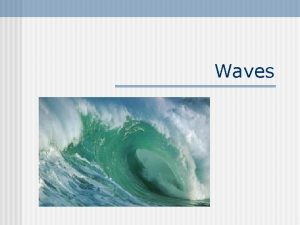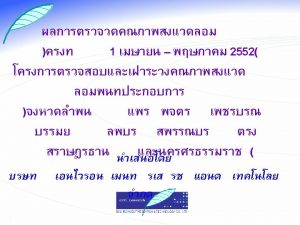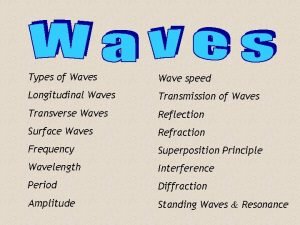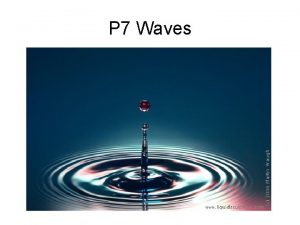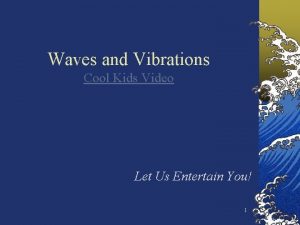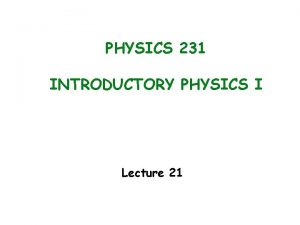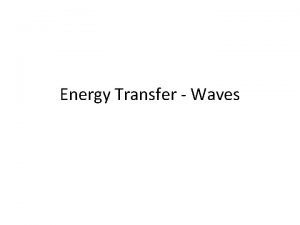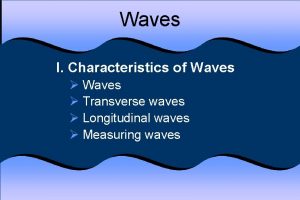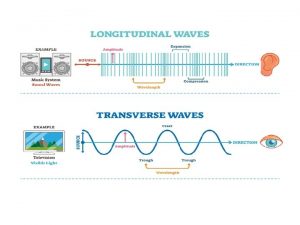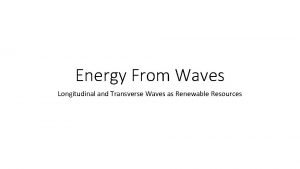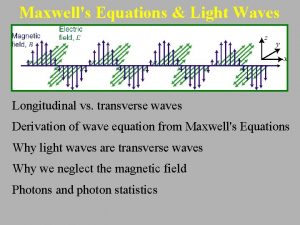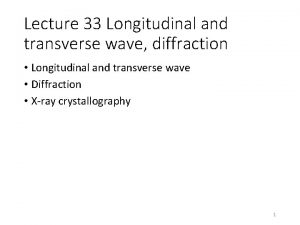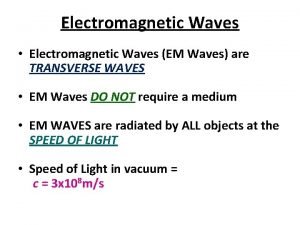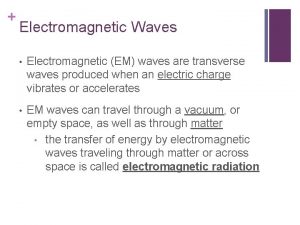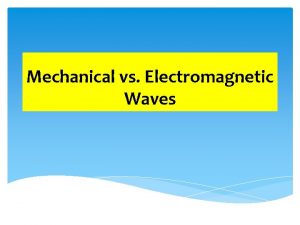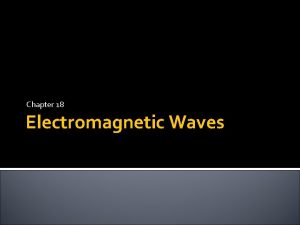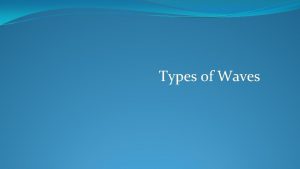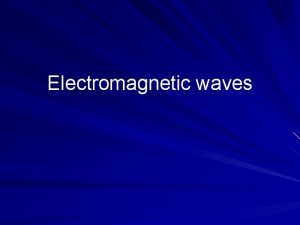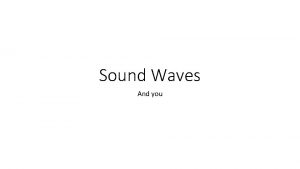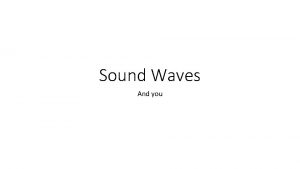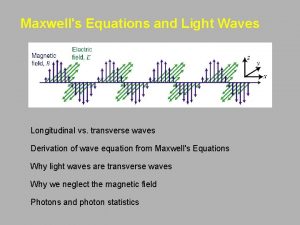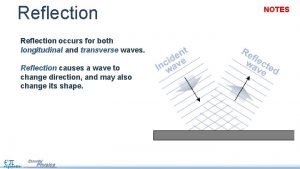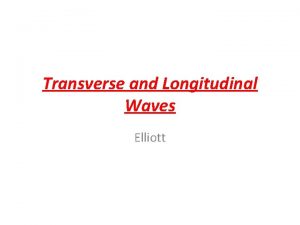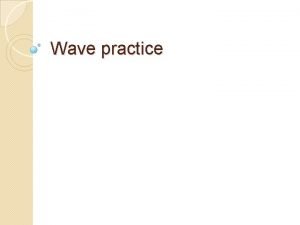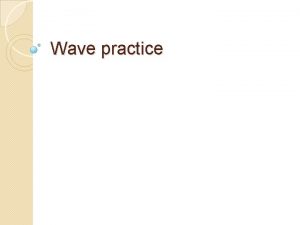6 Waves Topic overview Transverse and longitudinal waves
























- Slides: 24

6 Waves Topic overview Transverse and longitudinal waves • Waves are either transverse or longitudinal • In Transverse waves, the vibrations are at right angles to the direction of energy transfer. • In longitudinal waves, the vibrations are parallel to the direction of energy transfer. • Longitudinal waves have areas of compression (C) and rarefaction (R). • When a wave moves through a medium, the medium does not move permanently. © Hodder & Stoughton 2016

6 Waves Topic overview Properties of waves © Hodder & Stoughton 2016

6 Waves Topic overview Wave equation © Hodder & Stoughton 2016

6 Waves Topic overview Reflection © Hodder & Stoughton 2016

6 Waves Topic overview Transmission and absorption of waves • A mirror is an example of a near perfect reflector. o A hard surface, e. g. walls or rocks will reflect sound. • Other surfaces will either transmit or absorb waves. • Some of the waves may pass through the surface and change speed. o If the wave passes through the surface at an angle, the change of speed will cause a change in direction of travel. • Other surfaces may absorb the wave, e. g. o black paint absorbs light o special surfaces can be used to absorb sound in a concert hall or recording studio o modern buildings are often designed to absorb sound. © Hodder & Stoughton 2016

6 Waves Topic overview Sound waves • Sound o is a longitudinal wave o is produced by vibrating objects o travels through air by a series of compressions and rarefactions o can travel through solids by causing vibrations in the solid. • The compressions and rarefactions in sound waves reaching the eardrum cause the eardrum to vibrate. o This vibration is transferred to the inner ear and causes nerve impulses to be sent to the brain. • The range of human hearing is between 20 Hz and 20 k. Hz although this depends on age and other factors. © Hodder & Stoughton 2016

6 Waves Topic overview Waves for detection and exploration • Ultrasound has frequencies above 20 k. Hz, the upper limit of human hearing. • Ultrasound is used for: o medical imaging, e. g. foetal scanning o sonar: depth measurements and ocean exploration o fishing: to find shoals of fish o industrial imaging, e. g. finding cracks in railway lines. © Hodder & Stoughton 2016

6 Waves Topic overview Waves for detection and exploration • Ultrasound is used for medical imaging, e. g. foetal scanning © Hodder & Stoughton 2016

6 Waves Topic overview Seismic waves • Seismic waves are either: o P-waves which are longitudinal o S-waves which are transverse. • P-waves travel through both solid and liquid rock. They travel at different speeds in each. • S-waves cannot travel through a liquid. • The different waves and their different speeds can be used to investigate the structure of the Earth’s core. © Hodder & Stoughton 2016

6 Waves Topic overview Electromagnetic waves • Electromagnetic waves: o are transverse waves o transfer energy from one place to another o travel through a vacuum o have a wide range of wavelengths from about 10 -12 m to over 103 m o all travel at the same speed in a vacuum; 300 000 m/s (3. 0 x 108 m/s) • The range of wavelengths is called the electromagnetic spectrum. © Hodder & Stoughton 2016

6 Waves Topic overview Properties of electromagnetic waves 1 • Different wavelengths are reflected, refracted, transmitted and absorbed differently by different substances. • Refraction occurs when a wave travels from one medium to another at an angle because the wave has different speeds in the different mediums. © Hodder & Stoughton 2016

6 Waves Topic overview Properties of electromagnetic waves 2 • Radio waves and microwaves are produced by oscillating charges in an electrical circuit. • When received, the radio waves causes an alternating current in a circuit. Electromagnetic waves from infra-red to X-rays: oare emitted when changes in atoms occur ocause changes in atoms when they are absorbed by the atom. • γ-rays are emitted when changes occur in the nucleus of an atom. o. When this happens, the nucleus loses energy. © Hodder & Stoughton 2016

6 Waves Topic overview Hazards of electromagnetic waves • Ultraviolet, X-rays and γ-rays can cause mutations in the cells of the body. o This damages or kills the cells. • Higher frequencies cause more damage. o Ultra-violet radiation from the Sun in excess can cause skin cancer. o X-rays and γ-rays are used medically and the dose received is carefully controlled so that the benefit outweighs the risk. • Radiation dose is measured in sievert (Sv) which is a measure of the damage to living tissue. © Hodder & Stoughton 2016

6 Waves Topic overview Uses and applications of electromagnetic waves • Electromagnetic waves have many uses and applications: o Radio waves: used for communications, radio and television. o Microwaves: used for satellite communication and mobile phones. Microwaves are used for cooking food as some wavelengths are absorbed by water molecules. o Infra-red: used for heating and cooking. Infra-red is also used for remote controls and for night-time photography. o Light: as well as using light to see, it is used in fibre-optic communications. Lasers are used for fibre optics and in medicine and industry. o Ultra-violet: some substances absorb ultra-violet and re-emit it as visible light – called fluorescence. Fluorescent lamps make use of this. Ultra-violet is also used for security marking. o X-rays and γ-rays are used for medical imaging and treatment. © Hodder & Stoughton 2016

6 Waves Topic overview Lenses • Optical instruments use lenses to form images. • Lenses rely on refraction to change the direction of light. • There are two types of lens: o Converging (convex) lens, shown in (a) o Diverging (concave) lens, shown in (b) © Hodder & Stoughton 2016

6 Waves Topic overview Converging lenses • Parallel rays of light entering a convex lens meet at the principal focus. • The distance between the centre of the lens and the principal focus is the focal length of the lens. • When a lens forms an image on a screen, the image is called a real image. © Hodder & Stoughton 2016

6 Waves Topic overview Ray diagrams • Ray diagrams can be used to find the position of an image. • Any two of three rays are drawn from the top of the object: 1. 2. 3. • • a ray parallel to the principal axis which then passes through the focus a ray that passes straight through the centre of the lens undeviated a ray that passes through the focus and emerges parallel to the principal axis. Where the rays meet is the top of the image. The image is inverted. © Hodder & Stoughton 2016

6 Waves Topic overview Magnification © Hodder & Stoughton 2016

6 Waves Topic overview Diverging lenses • Parallel rays of light entering a concave lens are spread out. • The rays appear to come from a point called the virtual focus. • Ray diagrams are drawn in the same way as for a converging lens. • A virtual image is formed where the rays appear to cross; it cannot be seen on a screen. • The image is always: o virtual o upright o diminished. © Hodder & Stoughton 2016

6 Waves Topic overview Visible light • Each colour in the visible spectrum has a different band of frequencies. • Light is reflected: o from a smooth surface in a single direction. This is called specular reflection o from a rough surface in a variety of directions. This is called diffuse reflection. © Hodder & Stoughton 2016

6 Waves Topic overview Visible light • Coloured filters absorb all wavelengths of light apart from a narrow range which they transmit. • Opaque objects have colour because certain wavelengths of light are strongly reflected while others are absorbed. • A black object absorbs all wavelengths and a white object reflects all wavelengths. • Objects that transmit light are transparent or translucent. © Hodder & Stoughton 2016

6 Waves Topic overview Black body radiation • Everything emits and absorbs radiation. o The hotter the body, the more radiation it emits. o As temperature increases more of the energy is emitted as visible light. o The higher the temperature, the shorter the wavelength of visible light emitted. • A perfect black body absorbs all the radiation it receives. • Good absorbers are good emitters so a black body is a good emitter. o A body at constant temperature absorbs radiation at the same rate as it emits radiation. o If a body: § receives more radiation than it emits, the body warms § emits more radiation than it receives, the body cools. © Hodder & Stoughton 2016

6 Waves Topic overview The earth and radiation • The temperature of the Earth depends on many factors including the rate of absorption and emission of radiation and the amount of radiation reflected. • It is hotter at the equator because more radiation is incident on the Earth at the equator than at the poles. © Hodder & Stoughton 2016

6 Waves Topic overview The earth and radiation • At night radiation is emitted into space but none absorbed so the Earth cools. • In the day, clouds reflect some radiation back into space so Earth is cooler. • At night, clouds reflect radiation back from the Earth so keeping Earth warmer. © Hodder & Stoughton 2016
 Draw and label a longitudinal wave
Draw and label a longitudinal wave Compare and contrast transverse and longitudinal waves
Compare and contrast transverse and longitudinal waves Medium of a wave
Medium of a wave Transverse vs longitudinal waves
Transverse vs longitudinal waves Sound is a longitudinal wave
Sound is a longitudinal wave Light is an electromagnetic wave true or false
Light is an electromagnetic wave true or false Combined framing system
Combined framing system Double bottom construction
Double bottom construction Wavelength formula triangle
Wavelength formula triangle Structure of cerebrum
Structure of cerebrum Longitudinal transverse vertical
Longitudinal transverse vertical Retroperitoneal organs
Retroperitoneal organs Wave list
Wave list Longitudianl waves
Longitudianl waves Low amplitude wave
Low amplitude wave Transverse waves for kids
Transverse waves for kids Transverse waves
Transverse waves Transverse waves def
Transverse waves def Transverse standing waves
Transverse standing waves Energy transfer in transverse waves
Energy transfer in transverse waves How to write a clincher sentence
How to write a clincher sentence Narrowed down topic
Narrowed down topic Compare and contrast p waves and s waves using venn diagram
Compare and contrast p waves and s waves using venn diagram Energy that travels through
Energy that travels through How are rainbows made
How are rainbows made



